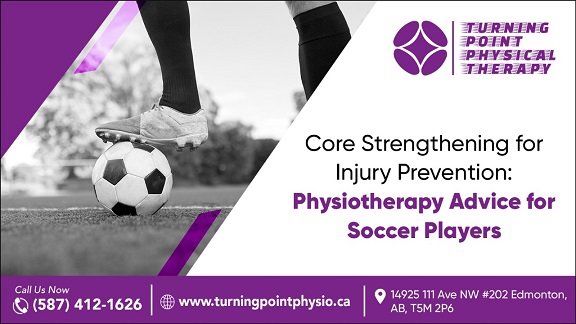Core Strengthening for Injury Prevention: Physiotherapy Advice for Soccer Players

In soccer, agility, speed, and endurance are crucial, but so is injury prevention. Sports physiotherapy Edmonton understands the demands placed on soccer players and offers specialized physiotherapy advice to optimize core strength for injury prevention.
The Importance of Core Strengthening
Core strengthening is vital for soccer players. A strong core enhances stability, balance, and coordination through injury prevention. The core muscles, including abdominals, obliques, lower back muscles, and pelvic floor, provide a solid foundation for all movements.
Core Strengthening Exercises for Soccer Players
1. Planks
Static Planks:
- How to Do It: Lie face down with forearms on the ground and elbows aligned under shoulders. Lift your body off from the ground, keeping it in a straight line from head to heels.
- Benefits: It engages the entire core, including the abdominis, transverse abdominis, and obliques, providing a strong and stable trunk. This exercise helps prevent soccer injuries by strengthening core muscles for stability and balance.
Dynamic Planks:
- Variations: Include side planks, plank with shoulder taps, and plank with leg lifts.
- Benefits: It adds dynamic movement, further challenging the core and improving overall stability, essential for reducing the risk of soccer injuries.
2. Russian Twists
- How to Do It: Sit on the ground with knees bent and feet flat. Lean back slightly, keeping your back straight. Hold a weight with both hands and rotate your torso from side to side.
- Benefits: Enhances rotational core strength, essential for movements such as kicking and turning during play, thereby reducing the risk of soccer injuries.
3. Pallof Press
- How to Do It: Stand sideways to a resistance band anchored at chest height. Hold the band with both hands, step away to create tension, and extend your arms forward, resisting the rotational force.
- Benefits: Improves core stability against rotational forces, strengthens the muscles that prevent excessive rotation, and protects the spine, which helps avoid soccer injuries.
4. Single-leg Balance Exercises
- Examples Include single-leg stands, single-leg deadlifts, and single-leg squats.
- Benefits: These exercises enhance proprioception and stability, crucial for maintaining balance and control during dynamic movements. They also strengthen the core and lower body muscles, reducing the risk of soccer injuries from uneven playing surfaces.
Common Soccer Muscle Injuries
Soccer is a physically demanding sport that leads to muscle injuries due to high-intensity running, sudden stop-starts, changes in direction, and frequent physical contact. Here are some of the most common muscle injuries the soccer players may experience, including specialized care from sports physiotherapy in Edmonton:
Hamstring Strains
Hamstring strains are soccer’s most prevalent muscle injuries, accounting for up to 50% of such injuries. These strains often occur during high-speed running or kicking motions and are more common in males. Key factors contributing to hamstring strain injuries include:
- Persistent weakness
- Reduced muscle-tendon extensibility
- Compensatory movement patterns
- Premature return to play
The primary modifiable risk factor is insufficient eccentric hamstring strength. Eccentric exercises, such as the Nordic Hamstring Curl, have reduced hamstring strain injuries by up to 51% in soccer players. These exercises enhance muscle fascicle length and eccentric strength, which is crucial for preventing over-stretching by sports injury physiotherapy.
Nordic Hamstring Curl Key Exercises:
- Starting Position: Kneel on a padded surface with your ankles secured under a sturdy object or held by a partner.
- Movement: Slowly lower your upper body towards the ground, keeping your back straight. Use your hamstrings to control the descent. Once you can no longer control the movement, catch yourself with your hands and push back up to the starting position.
- Focus: Emphasize the eccentric (lowering) phase to maximize muscle engagement.
Adductor Strains
Adductor strains, affecting muscles like the adductor magnus and brevis, are common due to soccer’s high eccentric contraction demands. Risk factors include muscle strength imbalances between the hip adductors and abductors.
Copenhagen Adductor Exercise
- This exercise demands high muscle activity of the adductor and abdominal muscles, which is essential for preventing groin problems.
- Equipment Needed: Use a bench or sturdy platform (knee height) and, optionally, a resistance band.
- Starting Position: Lie on your side with your bottom elbow bent to support your top leg on the bench with your knee at 90 degrees.
- Movement: Lift hips off the ground, keeping the body straight from shoulders to ankles. Hold, then lower your hips back down.
- Repetitions and Sets: Begin with 2-3 sets of 8-12 reps per side. Increase as strength improves.
- Benefits: Strengthens inner thigh adductors, enhances stability, improves agility for sports requiring lateral movement, and complements lower body workouts.
Quadriceps Strains
The quadriceps muscle group, particularly the rectus femoris, is prone to strains due to its involvement in high-speed movements like sprints and kicking. Risk factors include poor muscle flexibility, inadequate eccentric strength, and previous injuries.
Reverse Nordic Hamstring Curl Exercise:
- Starting Position: Kneel on a padded surface with your feet flat and your body upright. Cross your arms over your chest or place your hands on your hips.
- Movement: Lean back as far as you can while keeping your body straight from your knees to your shoulders. Engage your core and quadriceps to control the descent. Once you reach your limit, use your quads to return to the starting position.
- Focus: Maintain a straight line from your knees to your shoulders, avoiding any arching of your back. This exercise enhances the quadriceps’ eccentric performance, reducing the strain risk.
Build a Strong Foundation: Core Strengthening Advice for Soccer Players
Effective core strengthening is not just about enhancing performance on the field; it’s about safeguarding against injuries that will sideline even the most dedicated soccer players. Focusing on targeted sports physiotherapy in Edmonton can significantly reduce soccer players’ risk of injuries and maintain peak physical condition throughout the season.
Contact Turning Point Physiotherapy in Edmonton today and schedule a personalized consultation with expert sports physiotherapists.
Don’t wait—invest in your athletic longevity and book your appointment now!












